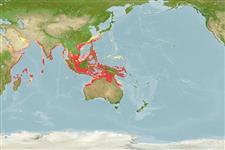Environment: milieu / climate zone / depth range / distribution range
Ecologia
marino demersale; distribuzione batimetrica 1 - 100 m (Ref. 9792), usually 20 - 50 m (Ref. 9792). Tropical; 26°N - 21°S, 43°E - 156°E (Ref. 54739)
Indo-West Pacific: Red Sea and East Africa to Japan and Australia.
Length at first maturity / Size / Peso / Age
Maturity: Lm 38.0, range 37 - 39 cm
Max length : 64.0 cm TL maschio/sesso non determinato; (Ref. 6006); common length : 50.0 cm TL maschio/sesso non determinato; (Ref. 5450); peso massimo pubblicato: 9.0 kg (Ref. 1468)
Spine dorsali (totale): 9 - 11; Raggi dorsali molli (totale): 38-45; Spine anali 1; Raggi anali molli: 33 - 43; Vertebre: 23 - 25. Body oval and flat, but thicker than in most other flatfishes. Mouth large with strong teeth; maxillary extends well beyond hind edge of lower eye; both eyes on left or right side; upper eye lying immediately below dorsal edge; gill rakers not developed. Dorsal fin origin well posterior to eyes; anterior fin rays spinous; lateral line almost straight. Color usually brown or grey, sometimes with 4 broad, dark crossbars. Dorsal, anal and caudal fin tips black. Blind side occasionally partially colored. (Other sources of morphological data: Refs. 591, 529, 4416, 5997 and 6000).
Found on sand and mud bottoms (Ref. 9796, 48637). Usually deeply burried in the substrate during the day, but out and hunting at night (Ref. 48637). Often swims in an upright position (Ref. 9796). Mainly piscivorous (Ref. 5986). Mainly sold fresh (Ref. 5213); also utilized smoked and frozen (Ref. 9987). Processed into fish flour (Ref. 6040).
Studies in Porto Novo, India (Refs. 5993 & 5997) show that the sex ratio significantly differ from 1:1, but the reports are ambiguous as to which sex predominates.
Nielsen, J.G., 1984. Psettodidae. In W. Fischer and G. Bianchi (eds.) FAO species identification sheets for fishery purposes. Western Indian Ocean fishing area 51. Vol. 3. (Ref. 3485)
IUCN Red List Status (Ref. 130435)
Threat to humans
Harmless
Human uses
Pesca: commerciale
Strumenti
Special reports
Download XML
Fonti Internet
Estimates based on models
Preferred temperature (Ref.
123201): 26.6 - 29.1, mean 28.2 °C (based on 1198 cells).
Phylogenetic diversity index (Ref.
82804): PD
50 = 0.7500 [Uniqueness, from 0.5 = low to 2.0 = high].
Bayesian length-weight: a=0.00676 (0.00507 - 0.00901), b=3.14 (3.06 - 3.22), in cm total length, based on LWR estimates for this species (Ref.
93245).
Trophic level (Ref.
69278): 4.4 ±0.3 se; based on diet studies.
Resilienza (Ref.
120179): Medio, tempo minimo di raddoppiamento della popolazione 1.4 - 4.4 anni (K=0.26-0.5; tm=3-4; Fec=300,000).
Prior r = 0.74, 95% CL = 0.49 - 1.11, Based on 3 stock assessments.
Fishing Vulnerability (Ref.
59153): Low to moderate vulnerability (29 of 100).
Climate Vulnerability (Ref.
125649): High to very high vulnerability (68 of 100).
Nutrients (Ref.
124155): Calcium = 122 [62, 249] mg/100g; Iron = 1.15 [0.54, 2.15] mg/100g; Protein = 18.4 [16.9, 19.9] %; Omega3 = 0.181 [0.080, 0.383] g/100g; Selenium = 68 [30, 151] μg/100g; VitaminA = 20.1 [6.2, 65.2] μg/100g; Zinc = 0.728 [0.470, 1.071] mg/100g (wet weight);
